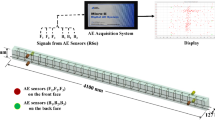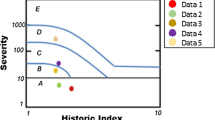Abstract
This article presents an experimental study on variation in acoustic emission (AE) parameters during cracking in reinforced concrete (RC) beams subjected to incremental cyclic loading in laboratory conditions. Nine RC beams with three different span-to-depth ratios ranging from 2.0 to 6.0 with a reinforcement ratio roughly kept the same (1.4–1.5 %) were tested under bending till failure and simultaneously the released AE was recorded. The criteria used to characterize the cracking in RC beams are based on the AE parameters. The AE parameters such as frequency, duration, amplitude, count, rise time, parameters depending on AE signatures such as b-value, and damage parameter D follow the fracture process during the entire loading. The results are useful to distinguish different cracks in RC beams and extend them for field applications.
















Similar content being viewed by others
Abbreviations
- AE:
-
Acoustic emission
- AF:
-
Average frequency
- RA:
-
Rise time
- D:
-
Damage parameter
- RC:
-
Reinforced concrete
References
Karihaloo BL (1995) Fracture mechanics and structural concrete. Longman Scientific & Technical, New York
Shah SP, Swartz SE, Ouyang C (1995) Fracture mechanics of concrete: applications of fracture mechanics to concrete, rock and other quasi-brittle materials. Wiley, New York
Bazant ZP, Planas J (1998) Fracture and size effect in concrete and other quasi brittle materials. CRC press, Boca Raton
van Mier JGM (1997) Fracture process of concrete, assessment of material parameters for fracture models. CRC press, Boca Raton
Grosse CU, Ohtsu M (2008) Acoustic emission testing. Springer, Heidelberg
Vidya Sagar R, Raghu Prasad BK (2012) A Review of recent development in parametric based acoustic emission techniques applied to concrete structures. Nondestruct Test Eval 27(1):47–68
Mindess S (2004) Acoustic emission methods. In: Malhotra VM, Carino NJ (eds) CRC handbook of nondestructive testing of concrete. CRC, Boca Raton
Chang PC, Liu SC (2003) Recent research in nondestructive evaluation of civil infrastructures. J Mat Civil Eng 15:298–304
JCMS-IIIB5706 (2003) Monitoring method for active cracks in concrete by acoustic emission, construction materials standard, Federation of Construction Materials Industries, Tokyo
Ohtsu M (2010) Recommendations of RILEM Technical Committee 212-ACD: acoustic emission and related NDE techniques for crack detection and damage evaluation in concrete: 3. Test method for classification of active cracks in concrete structures by acoustic emission. Mat Struct 43(9):1187–1189
Aggelis DG (2011) Classification of cracking mode in concrete by acoustic emission parameters. Mech Res Commun 38(3):153–157
Ohno K, Ohtsu M (2010) Crack classification in concrete based on acoustic emission. Const Build Mat 24(12):2339–2346
Ohtsu M, Tomoda Y (2007) Phenomenological model of corrosion process in reinforced concrete identified by acoustic emission. ACI Mat J 105(2):194–200
Polyzos D, Papacharalambopoulos A, Shiotani T, Aggelis DG (2010) Dependence of AE parameters on the propagation distance. In: Wakayama XV et al (ed) Progress in acoustic emission. Proceedings of the 20th international acoustic emission symposium, Japanese society for non-destructive inspection (JSNDI), Kumamoto, Japan, 16–19 November 2010, pp 43–48
Richter Charles F (1958) Elementary seismology. W.H. Freeman and company, San Francisco and London
Gutenberg B, Richter CF (1954) Seismicity of the earth and associated phenomena. Princeton University Press, Princeton
Aki K (1967) Scaling law of seismic spectrum. J Geophys Res 72:1217–1231
Main IG (1991) A modified Griffith criterion for the evolution of damage with a fractal distribution of crack lengths: application to seismic event rates and b-values. Geophys J Int 107:353–362
Turcotte DL, Newman WL, Shcherbakov R (2003) Micro and macroscopic models of rock fracture. Geophys Int J 152:712–728
Carpinteri A, Lacidogna G, Puzzi S (2009) From criticality to final collapse: evolution of b-value 1.5 to 1.0. Chaos Solitons Fractals 41:843–853
Rao MVMS, Prasanna Lakshmi KJ (2005) Analysis of b-value and improved b-value of acoustic emissions accompanying rock fracture. Curr Sci 89:1577–1582
Colombo IS, Main IG, Forde MC (2003) Assessing damage of reinforced concrete beam using b-value analysis of acoustic emission signals. J Mat Civ Eng 15(3):280–286
Cox SJD, Meridith PG (1983) Microcracking formation and material softening in rock measured by monitoring acoustic emissions. Int J Rock Mech Min Sci Geomech Abs 30:11–24
Ohtsu M, Ono K (1984) A generalized theory of acoustic emission and Green’s functions in a half space. J Acoust Emiss 3(1):124–133
Ohno K, Ohtsu M (2008). Mechanisms of concrete fracture analyzed by AE–SiGMA with automatic detector of first motion. In: Proceedings of international conference on fracture; [in CD-ROM]
Indian standard code of practice for plain and reinforced concrete (2002) IS 456: 2000, fourth revision. Bureau of Indian Standards, New Delhi
Aggelis DG, Matikas TE, Shiotani T (2010) Advanced acoustic techniques for health monitoring of concrete structures. In: Kim SH, Ann KY (eds) The song’s handbook of concrete durability. Middleton Publishing Inc., pp 331–378
Aggelis DG, Shiotani T, Momoki S, Hirama A (2009) Acoustic emission and ultrasound for damage characterization of concrete elements. ACI Mat J 106(6):509–514
Aggelis DG, Shiotani T, Terazawa M (2010) Assessment of construction joint effect in full-scale concrete beams by acoustic emission activity. J Eng Mech 136(7):906–912
Curtis GJ (1975) Acoustic emission energy relates to bond strength. Non-Destruct Test 8(5):249–257
Shiotani T, Aggelis DG, Makishima O (2009) Global monitoring of large concrete structures using acoustic emission and ultrasonic techniques: case study. J Brid Eng 14(3):188–192
Soulioti D, Barkoula NM, Paipetis A, Matikas TE, Shiotani T, Aggelis DG (2009) Acoustic emission behavior of steel fibre reinforced concrete under bending. Const Build Mat 23:3532–3536
Yuyama S, Li Z, Ito Y, Arazoe M (1999) Quantitative analysis of fracture process in RC column foundation by moment tensor analysis of acoustic emission. Const Build Mat 13:87–97
Schumacher T, Higgins C, Lovejoy S (2011) Estimating operating load conditions on reinforced concrete highway bridges with b-value analysis from acoustic emission monitoring. Struct Health Monit 10:17–32
Acknowledgments
This work was financially supported by Centre for infrastructure, Sustainable Transportation and Urban Planning (CiSTUP), Indian institute of science, Bangalore India via the research project CIST/MCV/RV/008.
Author information
Authors and Affiliations
Corresponding author
Rights and permissions
About this article
Cite this article
Vidya Sagar, R., Raghu Prasad, B.K. Laboratory investigations on cracking in reinforced concrete beams using on-line acoustic emission monitoring technique. J Civil Struct Health Monit 3, 169–186 (2013). https://doi.org/10.1007/s13349-013-0036-5
Received:
Revised:
Accepted:
Published:
Issue Date:
DOI: https://doi.org/10.1007/s13349-013-0036-5




